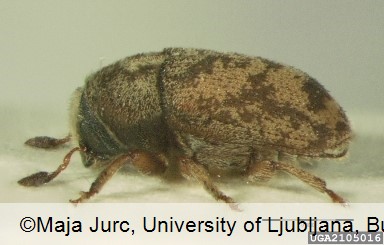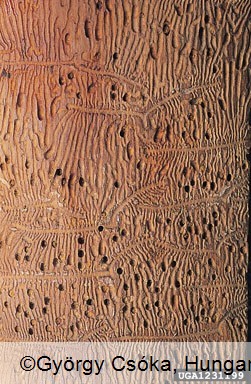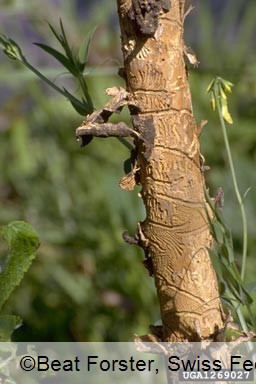Animalia
Ash bark beetle
Hylesinus fraxini
Maarten de Groot
|
|

Fig. 1. Adult of Hylesinus fraxini

Fig. 2. Galleries of Hylesinus fraxini

Fig. 3. Characteristic galls caused by hibernating galleries of Hylesinus fraxini

Fig. 4. Galleries of Hylesinus fraxini
DETECTION PERIOD:
March-May (flight period), whole year (damage)
DESCRIPTION:
Adults are small dark brown bark beetles (2.5-3.5 mm). antenna, and legs are red brown. The upper side of the body are covered with dark and light spots. The adults are making a characteristic V-shaped gallery system in the cambium from which the larvae are meandering perpendicular of the maternal tunnels into the wood. The adults are hibernating in overwintering galleries which give the characteristic galls on the bark.
HABITAT:
The main host of this species are ash species (Fraxinus spp.) but it is also found on Olea europaea, Syringa vulgaris, Juglans nigra, Quercus robur, Robinia pseudoacacia, Malus, Corylus avellane, Carpinus betulus.
STATUS:
Occurs in all countries in the REFOCuS area (Austria, Croatia, Hungary, Serbia and Slovenia).
IMPACT:
Larvae of the ash bark beetle are feeding on cambium of the trees. When in high populations the species can cause dieback of trees. However, it attacks mainly already weakened trees. It attacks ash trees of all age classes.
SIMILAR SPECIES:
Can be confused with other bark beetles on ashes like H. crenatus and H. oleiperda. The adult is very characteristic and the only bark beetle with such a pattern on the body. The gallery system is similar to H. crenatus, but is narrower. Damage of diseases causing dieback look superficially similar as H. fraxini, but when checking under the bark there are no gallery system.
|